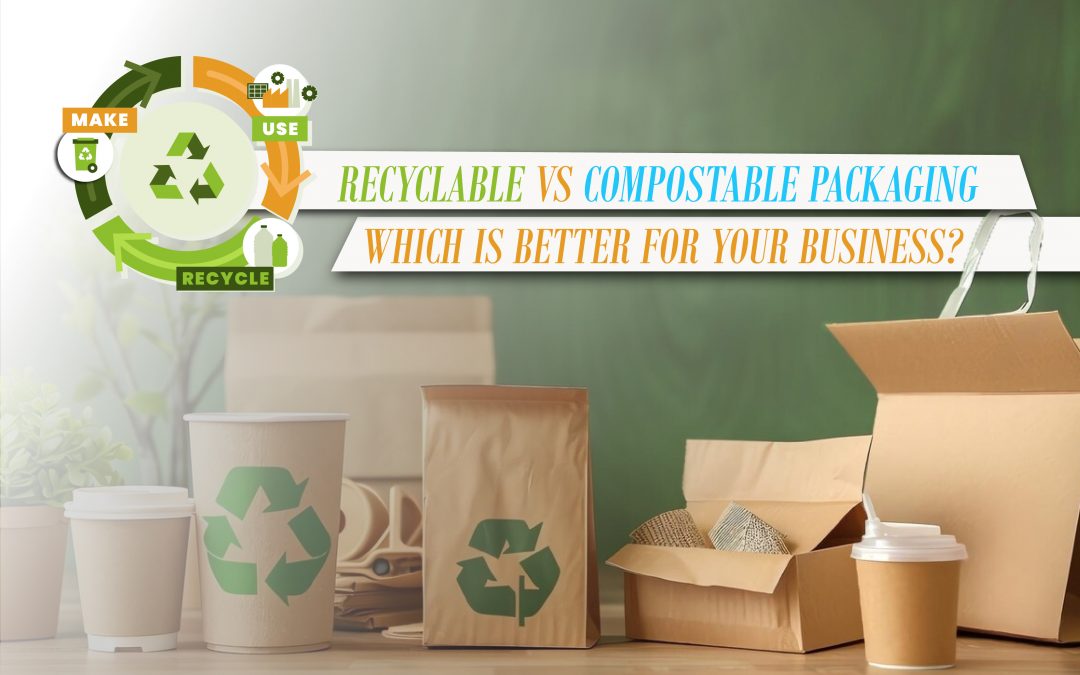In today’s eco-conscious world, businesses are increasingly turning to sustainable packaging options to reduce their environmental footprint and meet growing consumer demand for greener products. Two popular options that often come up in the conversation are recyclable and compostable packaging. But which one is better for your business? Let’s dive into the details to help you make an informed decision.
Understanding the Basics: Recyclable vs. Compostable Packaging
Recyclable Packaging refers to materials that can be processed and reused in the manufacturing of new products. Common recyclable materials include paper, cardboard, glass, and certain plastics. According to the Environmental Protection Agency (EPA), recycling one ton of paper saves 17 trees, 7,000 gallons of water, and enough energy to power the average American home for six months.
Compostable Packaging, on the other hand, is made from organic materials that can break down into nutrient-rich compost in a composting environment. These materials are often plant-based and can include items like paper, cardboard, bioplastics, and certain types of biodegradable plastics. The U.S. Composting Council reports that composting organic waste, including compostable packaging, can reduce greenhouse gas emissions by up to 50%.
Environmental Impact
When it comes to environmental impact, both recyclable and compostable packaging have their benefits.
Recyclable Packaging:
- Pros: Recyclable packaging helps reduce the demand for raw materials, lowers energy consumption in production, and decreases the amount of waste sent to landfills. For example, recycling aluminum cans saves 95% of the energy required to make the same amount of aluminum from raw materials.
- Cons: Not all recyclable materials are recycled equally. For instance, in 2020, the recycling rate for plastics in the U.S. was just 9%, meaning the majority of plastic waste still ends up in landfills or the environment. Additionally, recycling processes can consume significant energy, and contamination of recyclable materials can lead to them being sent to landfills instead.
Compostable Packaging:
- Pros: Compostable packaging offers a zero-waste solution when properly disposed of in composting facilities. It can break down naturally, enriching the soil without leaving toxic residues. A study by the Ellen MacArthur Foundation found that compostable packaging could help cut down food waste by 27%, as it often facilitates better waste separation and collection.
- Cons: Compostable packaging requires specific conditions to break down effectively, which may not be available in all regions. If compostable materials end up in regular landfills, they may not decompose as intended, leading to methane emissions. Furthermore, only 4% of U.S. food waste is composted, highlighting the limited infrastructure available for compostable materials.
Cost Considerations
Cost is a significant factor for any business when choosing packaging options.
Recyclable Packaging: Typically, recyclable packaging materials are widely available and often cost-effective, especially for large-scale production. However, the price can vary depending on the material and the recycling process’s efficiency. According to a report by the Sustainable Packaging Coalition, the cost of producing recycled content can be 5-10% lower than using virgin materials, depending on the material type and market conditions.
Compostable Packaging: Compostable materials can be more expensive than traditional or recyclable options due to the costs associated with sourcing and processing plant-based materials. For instance, compostable plastic can cost 25-50% more than conventional plastic. However, as demand for compostable packaging grows, prices may become more competitive.
Consumer Perception and Brand Image
Consumers are increasingly valuing sustainability, and your packaging choices can significantly impact your brand’s image.
Recyclable Packaging: Using recyclable packaging signals to consumers that your business is committed to sustainability. A 2021 survey by Trivium Packaging found that 74% of consumers are willing to pay more for sustainable packaging, with 82% expressing that recycling is important to them.
Compostable Packaging: Compostable packaging can enhance your brand’s green credentials, particularly among consumers who are highly committed to environmental sustainability. The same Trivium Packaging survey indicated that 67% of consumers favor products in compostable packaging, particularly in markets where composting infrastructure is well-developed.
Practicality and Infrastructure
The effectiveness of recyclable and compostable packaging largely depends on local infrastructure.
Recyclable Packaging: Most communities have established recycling programs, making it easier for consumers to dispose of recyclable packaging correctly. The EPA reports that in 2018, the U.S. recycling rate was 32.1%, with over 69 million tons of material recycled.
Compostable Packaging: Compostable packaging requires access to industrial composting facilities, which may not be available everywhere. In the U.S., only about 185 composting facilities can handle compostable plastics, compared to over 20,000 recycling facilities nationwide. Home composting is an option for some types of compostable packaging, but not all consumers have the means or knowledge to do so.
Which Is Better for Your Business?
The decision between recyclable and compostable packaging depends on several factors, including your business model, target market, and environmental goals. Here are a few questions to consider:
- What are your environmental priorities? If your primary goal is to minimize waste and keep materials in circulation, recyclable packaging may be the better option. If you’re focused on reducing plastic pollution and supporting soil health, compostable packaging might be the way to go.
- What infrastructure is available in your area? Assess the recycling and composting facilities available in your region. Choosing packaging that aligns with local waste management capabilities can enhance the effectiveness of your sustainability efforts.
- What do your customers care about? Understanding your customers’ values is crucial. If they are highly environmentally conscious, they may appreciate the extra effort that compostable packaging represents. However, if they are more accustomed to recycling, recyclable packaging might be more practical.
Conclusion
Both recyclable and compostable packaging offer significant environmental benefits, but the right choice for your business depends on your specific needs and circumstances. By carefully considering the environmental impact, cost, consumer perception, and practicality of each option, you can select packaging that aligns with your business goals and resonates with your customers. Whether you choose recyclable or compostable packaging, taking steps towards sustainability is a positive move for both your business and the planet.












